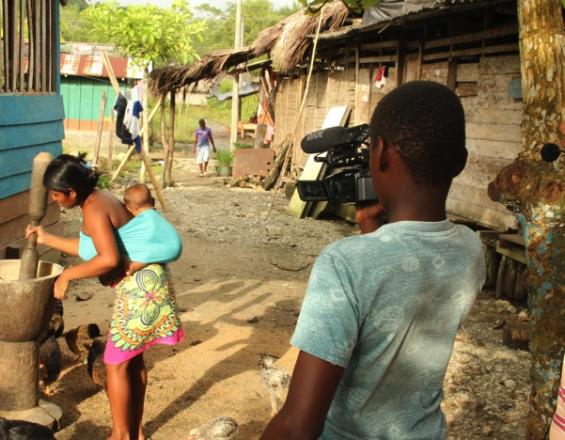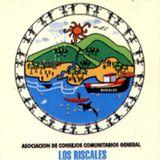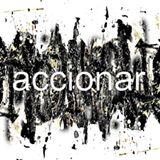
Communication as a tool for local governance in the Gulf of Tribugá
Full Solution

Young people who gradually became involved in the video workshops
MarViva
Community outreach and engagement strategies for the management of mangroves have been promoted in the Gulf of Tribugá, seeking the well-being of the local communities, the preservation of their culture and the protection of natural resources.
Last update: 30 Sep 2020
7795 Views
Context
Challenges addressed
Foster local governance, publicize current work and increase participation in planning
The mangrove is vital for inhabitants in the Gulf of Tribugá, so they decided to develop management plans to identify the status of mangroves, propose zoning strategies and rules of use. It was paramount to achieve broad participation of communities and effective dissemination of the process. The Communication Collective served as a channel to broadcast activities and to encourage participation.
Location
Nuquí, Chocó, Colombia’s Pacific coast
South America
Process
Summary of the process
Getting inserted into the communities and developing a partnership based on trust and mutual interests "opens the door" to the participatory design of projects that are of interest to communities. This design and its implementation are more participatory and supported by a larger number of people. Formal communication mechanisms favor the transfer of information to the community, avoiding misinformation and raising interest in the process. The technologies used, inexpensive and easy to apply, allowed rapid dissemination of process, quickly reaching most of the population and ensuring that information flows properly in all sectors and that an appropriation of the process unfolds.
It is important to promote the empowerment of community structures so that they can make decisions, such as the creation of the Communication Collective, born with broad support from the communities. This process could not have been implemented without the technical training for young people, the technology transfer and the supply of equipment (cameras, microphones, radio station, etc.).The combination of these factors enabled the development and successful implementation of the process.
Building Blocks
Participatory methodologies
The "Communication Collective Puja" was created through training workshops and laboratories to encourage community participation in land use planning processes of the municipality of Nuquí.
During the Collective’s creation, formulation of the management plan in the region began, which was documented from the very beginning by the work of the Communication Collective.
Young people from communities, having been previously trained, dedicated themselves to the video production process, interviews with participants and audios for the local radio. This made possible that the community participated in the process.
The dissemination of the agreements of the process and the views of the community generated more interest, and people came to places where activities were being conducted and got involved in the dynamics.
With camera, video and audio recorder in hand, the Collective made possible that opinions were shared and that the process was presented in a dynamic and participatory manner. A growing enthusiasm and community participation were the results of the process, which included other community issues, such as medical assistance and flooding.
Enabling factors
The existence of a trained group of young people from the community made possible that the Collective had access to the community, without difficulties or reservations.
Having an active process (the development of the management plan) that was of interest to the community helped the process of communication and the participation of a large number of people.
The local radio station could reach all communities and disseminate notes and comments produced by the Collective.
Lesson learned
The design of a community communication strategy relies heavily on the existence of a real scenario and context in which the strategy will be developed and implemented. When communication is focused only as a theoretical exercise, it loses its reason for being, loses its justification and usefulness. The Communication Collective has been a successful example because it has grown together with exercises of collective construction that the community identified as relevant (such as the Management Plan). The Collective is an effective way to promote community participation and disseminate the achievements of the process. It was a success factor that technical support teams and communities developed strategies, scenarios and dynamics of knowledge and experience exchange before starting the intervention
Resources
Technology transfer
An alliance between General Community Council Los Riscales, MarViva Foundation and Laboratorio Accionar Foundation allowed the establishment of the Collective Communication. The aim of the Collective is to transform social practices, strengthen local governance processes and to build participatory scenarios of political advocacy.
Through announcements in the communities, a group of "monitors" responsible for performing the communication tasks was chosen. In the process of transfer of community communication techniques and capacity building for young people, it was crucial to facilitate self-teaching attitude and the ability to generate own projects and content. The Collective was also provided with basic equipment, such as inexpensive cameras for video photography, audio recorders and computers.
Through mobile laboratories in community radio and video communication, the Collective was trained in content development and equipment handling techniques. Each community chose the topics they wanted to work with, according to the interests and priorities in each community. The members of the Collective have had, since then, the possibility to practice, explore and produce autonomously their own content.
Enabling factors
The existence of a media vacuum in the region ensured the success of the initiative.
Being able to perform activities with low-cost and easy-to-handle equipment provided young people with the means to create audiovisual products.
Focusing on issues relevant to each community and not on general topics of national importance allowed rapid identification of communities with the products.
Lesson learned
Collective communication techniques are easily incorporated by young people from the communities.
Inexpensive audio-visual equipment is very effective in generating information of interest to the communities.
Content should focus on issues in which each community is interested. This ensures greater participation and commitment.
The generation of videos and radio programs allows communities to influence policy decisions on management of marine resources in their region. Collective communication processes consolidated social leadership within communities.
Insertion in the community
Building trust between MarViva and the Community Councils of each community has taken more than four years before the development of the Communication Collective. Creating an association between the Collective and the Foundation has been based on the respect for the interests, decisions and role of the Community Councils. This partnership has allowed the insertion of the Foundation in the communities where it is positively seen as a strategic partner. This integration has been strengthened by successful previous processes where communities have perceived the benefits of partnership and the "fair play" by the Foundation.
Enabling factors
Establish personal relationships with community leaders to meet and discuss one to one the vision of these community leaders.
Create participatory methods in making decisions that develop an acceptance and identification with the decisions taken.
Lesson learned
Invest time to create a strong partnership with communities is essential before achieving successful experiences. This relationship requires time and constant interactions with community leaders. It is important to establish clear rules for this interaction from the very beginning. The respect by the Foundation for community decisions and the avoidance of taking the leading role were elements that helped create that trust.
Impacts
The Mangrove Management Plan was developed through a participatory process in which the Communication Collective kept most of the public informed about the objectives and progress in the development of the Plan. This encouraged community participation and the successful implementation of the Plan. Now 75% of visits for the extraction of firewood and mussels happen in areas designated as ‘sustainable use’. 80% of the extracted mussels now meet the agreed minimum catch size (5 cm). Previously this amount was only around 50%.
Achieving these levels of compliance depended heavily on the strategy that the Communication Collective developed to support the management of these ecosystems and to inform people about this process.
The formation of the Communication Collective has made possible a regular production of videos and radio interviews on environmental and cultural issues, which increased participation of Chocó’s coastal communities in the process.
Beneficiaries
3785 people from the communities of the Gulf of Tribugá who participated in the process
Story
In the mangrove the communities find mollusks, fish, wood for construction and firewood to cook food. It is the strategic place where fish reproduce and then migrate to the surrounding seas; without mangroves fishing is difficult, and food is scarce. In addition to how important it is for subsistence, the mangrove is linked to many traditional, cultural and medicinal practices.
For this reason, in 2008, the General Community Council ‘Los Riscales’ decided to develop the Mangrove Management Plan with the support of several institutions. This process has enabled communities to identify the status of mangroves and propose zoning strategies and rules of use of resources. In two of the demarcated areas, the recovery and preservation zones, most uses of mangrove are restricted, while extraction of resources is regulated in the area of sustainable use.
Mangrove delegates and coordinators of the Mangrove Management Plan identified the importance of communication for disseminating the work being done and increasing community participation in this process.
Under this concept, the Communication Collective has been devoted to create videos and recordings that allow awareness raising on topics such as sea problems, the need for a management plan and progress in the design and implementation of this plan. A local radio station was established, which allows the dissemination of interviews and radio programs to inform and raise awareness of communities in the area.












